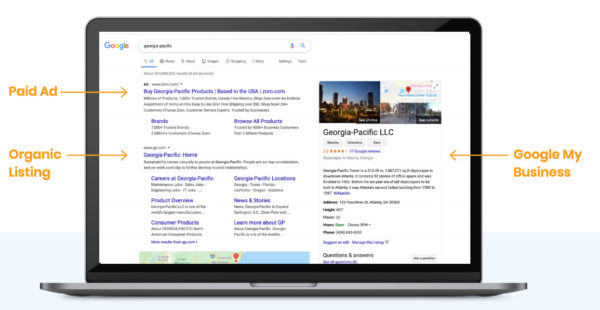
Let’s get right to it — you’re ready to embark on a campaign to gain more customers and find partners to help grow your business. Manufacturing advertising is an effective method to score new contracts, and this guide can help you get started.
Advertising, which involves implementing a dedicated budget and creating visually appealing ad content, can be a powerful part of a comprehensive marketing campaign for your company. However, manufacturing ads are no longer worth running in local newspapers. Instead, you should look to digital platforms.
Don’t think of social media and other online platforms as just places to find old high school friends, share pictures of your cat, or search for factoids. Today, people use LinkedIn, Facebook, and Google to find businesses like yours.
Industrial advertising can be targeted in ways that make campaigns cost-efficient while reaching the exact people you want to connect with your company.
Ready to get new manufacturing deals and repeat business — all in one place?
Start with a website
Before you initiate a digital advertising campaign, you must have an online home where people can visit to learn more about your manufacturing company. A well-designed website consisting of at least four pages outlining your products and services, sharing information about the history and values of your company, and detailing contact information is a requirement.
You’ll also want to make sure your website is designed with your customer in mind. This means making it easy to navigate, even on a mobile device. Make sure that the tone of your website also speaks directly to your target audience. The more you know about who you want to reach, the easier it will be to do so.
Understanding different ad styles
As you determine your budget for paid ads, you’ll need to understand how most digital ads work. In general, you are paying for a space on an online page. You want to make sure that the people who are seeing your ad are the people you want to reach.
Depending on the platform, you can pay for each time that someone actually clicks to learn more. That’s called PPC, or pay-per-click. Or, you may pay for a certain number of times that people simply view your ad. That’s known as PPI or pay-per-impression.

A final online ad style is known as display ads. While PPC and PPI are mostly text-based ads, display ads can include illustrations or photos. They often run as banners along the tops of web pages, so they are more noticeable. As a result, they are also usually more expensive.
Develop a LinkedIn presence
A good place to start with online advertising is LinkedIn, which is primarily used for business. By developing a strong presence on LinkedIn, you’ll be mimicking traditional word-of-mouth marketing.
You’ll want to first enhance your personal LinkedIn page since that’s how many people will connect with you. Take time to fully complete every section. Request recommendations from your current connections and reach out to other CEOs and COOs to widen your network.
Then, you can purchase digital ads on LinkedIn. These ads can (and should) be targeted so that the people who see them are involved with specific industries, companies, or positions.
Get social with Facebook
Without a doubt, Facebook remains one of the most popular social media platforms for Americans. To get started with advertising on Facebook, you’ll need to create a Facebook Business page for your company. This page can be used to share industry news, highlight new products, and help you learn more about what your potential customers want.
As you begin a consistent posting schedule for your business page, you’ll quickly see that Facebook algorithms make it challenging to grow organically. Paid advertising through Facebook, meanwhile, will ensure that your company’s message is seen by those who will be interested.
Using Facebook Business pages, you can create ads and target them to individuals geographically as well as by interest. You can create two different ads with different wording and images and see which one more people interact with. Then, you can direct resources to the ad that works best.
Most important: Google Ads
While social media is a great advertising opportunity, you should definitely plan to spend some of your budget on Google Ads. Professionals expect an ROI of $8 for every $1 spent on Google Ads, depending on how you set up your ads and choose your targeted keywords.
Keywords are how marketers describe the exact words that people type into the search box of Google when looking for something. Let’s say your customers want to buy your pipe fittings. They may type in “pipe fittings,” or they might type “fittings for pipes in Pittsburgh.”
There are online tools for determining the best keywords for your business, but the process can be detail-oriented and sometimes confusing. You’ll need to research what your competition uses and how crowded the market is to appropriately direct your resources. Constant Contact has a built-in Google Ads tool to simplify the process, and it’s worth checking out to save time.
How to decide on an ad budget
You’ve heard the saying, “You have to spend money to make money.” That’s the truth in advertising. A common mistake that new advertisers make is committing too little money when starting. Then they don’t see the results they expect, and they stop.
When starting a digital advertising campaign, commit to using at least $1,500 or $2,000 for Google Ads at first. That comes out to about $50 to $65 a day. You’ll set a time limit for the span that your ad will run. After a while, you’ll be able to get an idea of what works and what doesn’t, so you can refine your messaging and images to attract your target audience.
Integrate advertising into a marketing plan
Marketing professionals rarely rely on paid advertising alone when working to expand brand awareness or reach new customers. These options should be part of a comprehensive marketing initiative.
Along with creating an optimized website and social media presence, you’ll also want to collect email addresses for direct email marketing. These emails can include new content like educational blogs or instructional videos that you create to position yourself as a leader within your industry.
It’s also important that you work to manage your online reputation for listings and reviews. Check your company information on Google My Business and Facebook Business, along with other sites that may apply to your industry. Ask your loyal customers to write reviews and testimonials about their interactions with your company.
If a former customer posted an online review that was not flattering, you’ll need to address it as quickly as possible. Always remain professional when replying to a review. Use the reply to show potential customers that you prioritize customer service and care about providing a high-quality product.
To understand the big-picture perspective about what it takes to effectively market your business, be sure to check out our free guide to marketing for the manufacturing industry, The Download.




